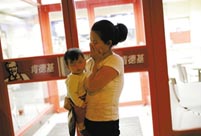 |
| A parent helps his child carrying luggage at the Anhui University in Hefei, capital of east China's Anhui Province, Aug. 27, 2013. Undergraduates for 2013 registered on the day. The university recruited 5,097 freshmen this year. (Photo/Xinhua) |
A host of retail shops in China have jumped on the back-to-school bandwagon this summer, as new college students and their splurging parents strive to keep up with the Joneses.
And keeping up with the Joneses is no joke. According to a recent news report that has attracted wide attention, a college student in Jiangsu province took his parents to court because they didn't have enough money to make his college dreams come true.
Although it is an extreme case, the story highlights the stark contrast among peers playing out on campuses nationwide.
Must-haves
Chinese parents these days are sparing no expense to make sure their kids are "prepared" for college.
Zhang Lin, a freshman ready to leave her hometown in Anhui province for a Shanghai university, has packed a laptop, smart phone and tablet which, combined, cost 13,000 yuan ($2,125), while her tuition comes in at 5,000 yuan a year.
But that's not "luxury," Zhang says, as every student around her owns such digital products. "Several classmates have digital cameras that cost nearly 10,000 yuan."
Electronic products have become essential for the new generation of college students, and stores across China have seen a rush to buy such products in the run-up to the new school year.
Parents have also been spending big for new clothes, bedding and other items for their kids.
One list of freshman "must-haves" released by an online store even includes a mountain bike and dolls. In Guangdong, some online stores have encouraged first-year students to go into debt to satisfy their materialist fantasies.
Love expenses
Speaking of fantasies, the Ningbo Institute of Technology, an affiliate of Zhejiang University, has advised parents not to give their children any more than 600 yuan a month for living allowances, yet has simultaneously encouraged students to purposefully seek out romance during their college years.
Netizens have commented on the irony, asking how anyone can be expected to date on 600 yuan a month.
According to an online survey of 5,000 netizens, nearly 80 percent of respondents agreed that the monthly expenditure of a college student can easily exceed 1,000 yuan.
Chen Lei, a junior at Renmin University, says he spends at least 600 yuan on food, 200 on books and another 200 on other expenses. "It costs even more if you're dating someone," he added.
Chen says that last Chinese Valentine's Day he bought a bunch of roses for his girlfriend and treated her to dinner at a Hong Kong-style restaurant. These romantic overtures alone cost him 500 yuan.
But some classmates go much further, Chen adds. One was particularly profligate in his pursuit of romance, spending nearly 5,000 yuan on jewelry for a potential love interest last Christmas.
Wealth gap
As new and returning students from across the wealth spectrum arrive at university, it is common to see freshmen lugging little suitcases and lining up for "welcome" packages of daily necessities and subsidies. Meanwhile, other students arrive in big expensive cars carrying more than ten suitcases, then proceed to hire porters to carry these belongings to the dormitory.
A decade ago, students from "rich" families had a monthly living allowance of about 400 yuan, while poor students had half that, according to a college professor. Now, he adds, rich students drive Mercedes-Benzes to college and their allowances are three or four times as high as many of their less well-off classmates.
Gaps in income between the poorest and richest of Chinese widened much further in the past few decades, and the economic differences on campuses are a reflection of the wider phenomenon in society, says Xiong Bingqi, deputy director of the 21st Century Education Research Institute.
It is important to teach students to adopt the right attitude towards wealth, he adds.
A Xinhua straw poll of students last year found that 80 percent felt the differences in family backgrounds during campus life.
 Mexican president delivers first State of Nation address
Mexican president delivers first State of Nation address Highlights of MAKS 2013 Int'l Aviation and Space Show
Highlights of MAKS 2013 Int'l Aviation and Space Show  10th China-ASEAN Expo opens in Nanning
10th China-ASEAN Expo opens in Nanning Baby born to save his sister - the story of a savior sibling
Baby born to save his sister - the story of a savior sibling Lady of mystery: Female SWAT team in prison disclosed
Lady of mystery: Female SWAT team in prison disclosed  Single mother, baby live in KFC restaurant for months
Single mother, baby live in KFC restaurant for months Top 10 naked hotels in the world
Top 10 naked hotels in the world The most gorgeous Chinese women in the eyes of foreigners
The most gorgeous Chinese women in the eyes of foreigners A collection of bizarre rooftop buildings around China
A collection of bizarre rooftop buildings around China Putin intimate contacts with marine animals
Putin intimate contacts with marine animals China's frigate 'Bengbu'in fire training
China's frigate 'Bengbu'in fire training Fresh students 'forced' to register in university independently
Fresh students 'forced' to register in university independently 2013 Taiwan Int'l Tourism Expo kicks off in Taipei
2013 Taiwan Int'l Tourism Expo kicks off in Taipei Photo story: Take a gap year
Photo story: Take a gap year Nokia's Global Headquarters: visiting a declining empire
Nokia's Global Headquarters: visiting a declining empireDay|Week|Month